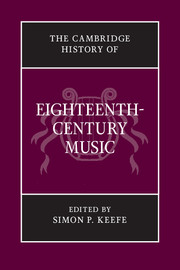Book contents
- Frontmatter
- PRELUDE
- PART I MUSIC FOR THE CHURCH
- INTERLUDE
- PART II MUSIC FOR THE THEATRE
- 8 Italian opera in the eighteenth century
- 9 Opera in Paris from Campra to Rameau
- 10 An instinct for parody and a spirit for revolution: Parisian opera, 1752–1800
- 11 German opera from Reinhard Keiser to Peter Winter
- 12 The lure of aria, procession and spectacle: opera in eighteenth-century London
- 13 Music theatre in Spain
- 14 Opera in Sweden
- INTERLUDE
- PART III MUSIC FOR THE SALON AND CONCERT ROOM
- POSTLUDE
- Appendix I Chronology
- Appendix II Institutions in major European cities
- Appendix III Personalia
- Index
- References
9 - Opera in Paris from Campra to Rameau
from PART II - MUSIC FOR THE THEATRE
Published online by Cambridge University Press: 28 March 2011
- Frontmatter
- PRELUDE
- PART I MUSIC FOR THE CHURCH
- INTERLUDE
- PART II MUSIC FOR THE THEATRE
- 8 Italian opera in the eighteenth century
- 9 Opera in Paris from Campra to Rameau
- 10 An instinct for parody and a spirit for revolution: Parisian opera, 1752–1800
- 11 German opera from Reinhard Keiser to Peter Winter
- 12 The lure of aria, procession and spectacle: opera in eighteenth-century London
- 13 Music theatre in Spain
- 14 Opera in Sweden
- INTERLUDE
- PART III MUSIC FOR THE SALON AND CONCERT ROOM
- POSTLUDE
- Appendix I Chronology
- Appendix II Institutions in major European cities
- Appendix III Personalia
- Index
- References
Summary
‘The clock is striking four; let’s go to the Opéra. We shall need at least an hour to get through the throng crowding the door.’ Dufresny’s evocative remark underscores the popularity of the Académie Royale de Musique, familiarly known as ‘the Opéra’, at the turn of the eighteenth century. A half-century later this Parisian institution remained a favourite gathering place for high society, a preoccupation of intellectuals and a symbol of the glory of the French monarchy. The discussion that follows focuses on the offerings of that theatre, with an occasional glance at the royal court and the early development of the Opéra-Comique. Two important and representative works are treated as case studies: Campra’s L’Europe galante and Rameau’s Hippolyte et Aricie.
The death of Jean-Baptiste Lully in 1687 signalled the end of an era for French opera. While the Opéra had been Lully’s personal fiefdom, where he was both impresario and sole composer, administration of the company now passed to his son-in-law, Jean-Nicolas Francine, who extended the opportunity to compose new works to several musicians and poets. In addition, Louis XIV no longer wished the Académie to bring its productions routinely to the royal court. Various reasons have been given, especially Louis’s preoccupation with religion and morality during this phase of his life, and his decision to embark on a costly war of aggression (the War of the League of Augsburg, 1688–97).
- Type
- Chapter
- Information
- The Cambridge History of Eighteenth-Century Music , pp. 272 - 294Publisher: Cambridge University PressPrint publication year: 2009

